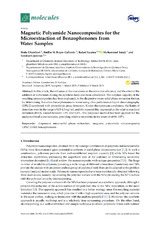Mostrar el registro sencillo del ítem
Magnetic Polyamide Nanocomposites for the Microextraction of Benzophenones from Water Samples
| dc.contributor.author | Ghambari, H. | |
| dc.contributor.author | Reyes-Gallardo, E.M. | |
| dc.contributor.author | Lucena, Rafael | |
| dc.contributor.author | Saraji, M. | |
| dc.contributor.author | Cárdenas, Soledad | |
| dc.date.accessioned | 2019-05-24T07:05:58Z | |
| dc.date.available | 2019-05-24T07:05:58Z | |
| dc.date.issued | 2019 | |
| dc.identifier.uri | http://hdl.handle.net/10396/18628 | |
| dc.description.abstract | In this article, the influence of the monomers on the extraction efficiency and the effect of the addition of surfactants during the synthesis have also been considered. The sorption capacity of the resulting nanocomposites has been evaluated, in the dispersive micro-solid phase extraction format, by determining that of six benzophenones in water using ultra performance liquid chromatography (UPLC) combined with photodiode array detection. Under the optimum conditions, the limits of detection were in the range of 0.5–4.3 ng/mL and the repeatability, expressed as the relative standard deviation (RSD), varied between 1.5% and 5.6%. The proposed method has been applied for the analysis of real water samples, providing relative recoveries in the interval of 84–105%. | es_ES |
| dc.format.mimetype | application/pdf | es_ES |
| dc.language.iso | eng | es_ES |
| dc.publisher | MDPI | es_ES |
| dc.rights | https://creativecommons.org/licenses/by/4.0/ | es_ES |
| dc.source | Molecules 24(5), 953 (2019) | es_ES |
| dc.subject | Dispersive micro-solid phase extraction | es_ES |
| dc.subject | Magnetic polyamide nanocomposite | es_ES |
| dc.subject | UPLC-DAD | es_ES |
| dc.subject | Benzophenones | es_ES |
| dc.title | Magnetic Polyamide Nanocomposites for the Microextraction of Benzophenones from Water Samples | es_ES |
| dc.type | info:eu-repo/semantics/article | es_ES |
| dc.relation.publisherversion | http://dx.doi.org/10.3390/molecules24050953 | es_ES |
| dc.relation.projectID | Gobierno de España. CTQ2017-83175R | es_ES |
| dc.rights.accessRights | info:eu-repo/semantics/openAccess | es_ES |

